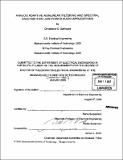Analog adaptive nonlinear filtering and spectral analysis for low-power audio applications
Author(s)
Salthouse, Christopher Donovan, 1978-
DownloadFull printable version (19.92Mb)
Other Contributors
Massachusetts Institute of Technology. Dept. of Electrical Engineering and Computer Science.
Advisor
Rahul Sarpeshkar.
Terms of use
Metadata
Show full item recordAbstract
Filters are one of the basic building blocks of analog circuits. For linear operation, the power consumption is proportional to the dynamic range for a given topology. I have explored techniques to lower the power consumption below this limit by extending operation beyond the linear range. First, I built a power-efficient linear gm-C filter that demonstrates that dynamic range can be shifted to higher linear ranges using capacitive attenuation. In a standard gm-C filter, the minimum noise is limited by the discrete charge on the electrons and holes stored on the capacitor. This noise can only be reduced by collecting more charge on a larger capacitor, consuming more power. The maximum signal is determined by the linear range of the transconductor. This work showed that both the noise and the maximum signal can be amplified by including a capacitive attenuator in the feedback path of filter. In order to increase the dynamic range, I explored the non-linear operation of the filters, including jump resonance. Unlike harmonic distortion and gain compression which slowly increase with the input amplitude, jump resonance is not present in a linear system, but develops in the presence of strong nonlinearity. (cont.) It is characterized by a discontinuous jump in the frequency response near the resonant peak. I have analyzed the behavior using both describing function and state-space techniques. Then, I developed a novel graphical analysis technique. Finally, I design, built, and tested a circuit for avoiding jump resonance for audio filters. Finally, I took advantage of nonlinearities in a filtering system to build a micropower companding speech processor. This system implements the companding speech processing algorithm to improve speech comprehension in moderate noise environments. The sixteen channel system increases the spectral contrast of speech signals by performing an adjustable two-tone suppression function, replacing the function of a normally function cochlea for hearing aid or cochlear implant users. The system runs on less than 60uW of power, a consumption so low it could run for 6 months on a standard hearing aid battery.
Description
Thesis (Ph. D.)--Massachusetts Institute of Technology, Dept. of Electrical Engineering and Computer Science, September 2006. "August 2006." Includes bibliographical references.
Date issued
2006Department
Massachusetts Institute of Technology. Department of Electrical Engineering and Computer SciencePublisher
Massachusetts Institute of Technology
Keywords
Electrical Engineering and Computer Science.